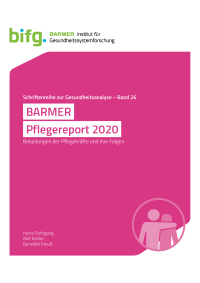
This year's BARMER Long-Term Care Report was presented today at the Conference Centre of the Federal Press Conference House in Berlin. The Report focuses this year on the analysis of stress and health status among care workers. The working time of 26,000 care workers was lost in the year 2017 due to an above-average disease burden. The Report discusses current long-term care policy with regard to the ongoing care crisis – particularly in the light of additional burdens brought on by the Corona pandemic. The authors – Professor Dr. Heinz Rothgang, Dr. Rolf Müller and Benedikt Preuß – carried out in-depth studies of case numbers, incidences, prevalences and long-term care trajectories. The figures are based primarily on the long-term care statistics for the year 2017 provided by the Federal Office of Statistics as well as routine claims data of the BARMER health insurance fund.
Workload considerably heavier in long-term care
Workloads have increased considerably in many respects for care workers. Around 92 per cent of geriatric care workers report that they often carry out their work standing up (cf. 47 per cent reported in other occupations). Seventy-six per cent of geriatric care workers report having to frequently lift and carry heavy weights (as against 15 per cent in other occupations). Working in forced postures is reported significantly more frequently (45 percent as compared to 11 per cent). Fifty-two per cent of geriatric carers report that they often have to comply with rules relating to minimum performance or stipulated times for carrying out specific tasks (as against 27 per cent in other occupations). Other pressures include frequent deadline and performance pressures (reported by 63 per cent compared to 50 per cent in other occupations); frequently having to work very quickly is reported by 53 per cent (cf. 39 per cent), and 31 per cent of geriatric care workers claim that they frequently reach the limits of their endurance (as against 16 per cent in other occupations). All these burdens are also reported to be stressful more frequently by care workers than by workers in other occupations.
Poorer Health Status among Care Workers
Correspondingly, care workers are found to be altogether in poorer health than workers in other occupations. This correlation is shown by all measurement methods used. Survey results, the analysis of outpatient diagnoses, absence rates, prescriptions and hospitalisation figures all show that care workers are more seriously affected by musculoskeletal, psychic and behavioural disorders. Though in many areas the workload is similar for qualified and for auxiliary geriatric care workers, the health status of auxiliary workers is poorer than among qualified care workers.
Very high absence rates through illness among care workers
Sickness rates stood at 7.2 per cent in 2017 among qualified geriatric care workers, and as high as 8.7 per cent among auxiliary carers; in other occupations, the sickness rate was 5.0 per cent. The above-average working time lost through sickness is calculated by multiplying the difference in sickness rates by the number of care workers. This surplus work time lost amounts to the working time of well over 24,000 care workers in the year 2017.
On average, within the year 2017 3.9 out of 1,000 geriatric care workers and six out of 1,000 auxiliary workers are granted disability pensions, while the rate among other occupations is three per 1,000. The above-average early retirement rates led to a loss of almost 2,000 care workers in 2017. The aggregate of above-aberage sickness-related absence times and the above-average entry into disability retirement pensions corresponds to the working time of 26,000 care workers lost in 2017 alone.
There is no alternative but to hire more staff
Current employment figures in care work are inadequate to ensure both professional care and salubrious working conditions. The work intensification arising out of this leads to an excessive workload and negative health effects for employees. This situation generates increased absence through sickness, and more people changing occupations, which in turn aggravates the care crisis. The vicious circle is complete when the remaining care workers are burdened with an even greater workload. This vicious circle has to be broken to ensure sustainable, quality-assured care work – and it can only be broken by employing more staff.
Downloads (all in German only):
BARMER Care Report 2020
Statement by Prof. Rothgang at the Press Conference
PresentatIon given by Prof. Rothgang at the Press Conference
Contact:
Prof. Dr. Heinz Rothgang
SOCIUM Research Center on Inequality and Social Policy
Mary-Somerville-Straße 3
28359 Bremen
Phone: +49 421 218-58557
E-Mail: rothgang@uni-bremen.de
Dr. rer. pol. Rolf Müller
SOCIUM Research Center on Inequality and Social Policy
Mary-Somerville-Straße 3
28359 Bremen
Phone: +49 421 218-58554
E-Mail: rmint@uni-bremen.de











